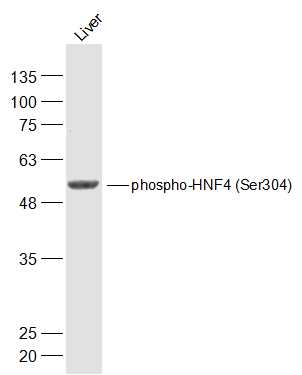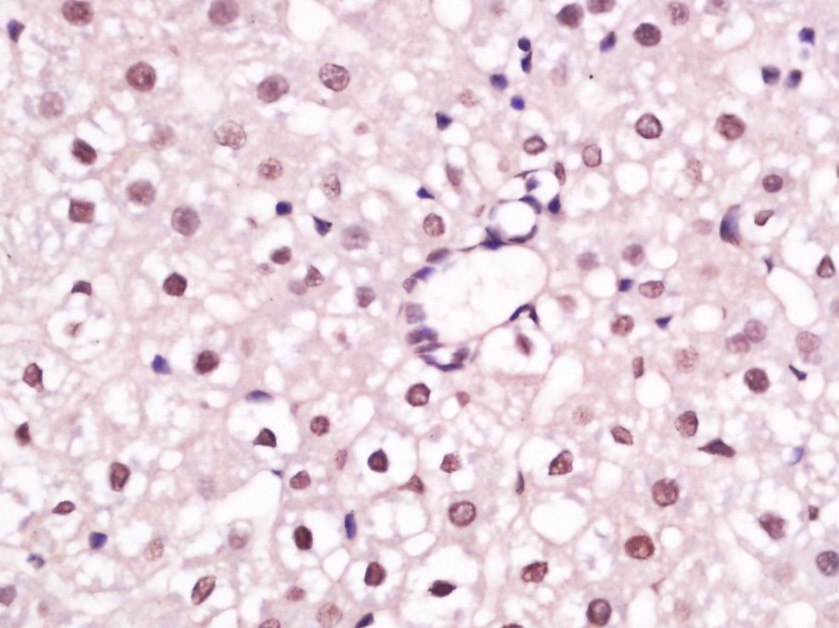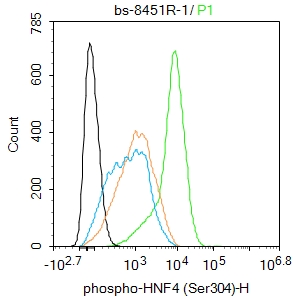
Rabbit Anti-phospho-HNF4 (Ser304)antibody
HNF4(Phospho-Ser304); Hepatic nuclear factor 4 alpha; Hepatocyte nuclear factor 4 alpha; Hepatocyte nuclear factor 4; HNF 4 alpha; HNF 4; HNF4; HNF4A; HNF4a7; HNF4a8; HNF4a9; Hnf4alpha; MODY 1; MODY; MODY1; NR2A1; NR2A21; Nuclear receptor subfamily 2 grou
View History [Clear]
Details
Product Name phospho-HNF4 (Ser304) Chinese Name 磷酸化肝The nucleus因子4α抗体 Alias HNF4(Phospho-Ser304); Hepatic nuclear factor 4 alpha; Hepatocyte nuclear factor 4 alpha; Hepatocyte nuclear factor 4; HNF 4 alpha; HNF 4; HNF4; HNF4A; HNF4a7; HNF4a8; HNF4a9; Hnf4alpha; MODY 1; MODY; MODY1; NR2A1; NR2A21; Nuclear receptor subfamily 2 group A member 1; TCF 14; TCF; TCF14; Tcf4; Transcription factor 14, hepatic nuclear factor; Transcription factor 14; Transcription factor HNF 4; Transcription factor HNF4; HNF4A_HUMAN. Product Type Phosphorylated anti Research Area Tumour Cell biology immunology Chromatin and nuclear signals Signal transduction transcriptional regulatory factor Kinases and Phosphatases Immunogen Species Rabbit Clonality Polyclonal React Species Human, Mouse, Zebrafish, (predicted: Rat, Chicken, Pig, Cow, Horse, Rabbit, Guinea Pig, ) Applications WB=1:500-2000 ELISA=1:5000-10000 IHC-P=1:100-500 IHC-F=1:100-500 Flow-Cyt=1ug/Test IF=1:50-200 (Paraffin sections need antigen repair)
not yet tested in other applications.
optimal dilutions/concentrations should be determined by the end user.Theoretical molecular weight 52kDa Cellular localization The nucleus Form Liquid Concentration 1mg/ml immunogen KLH conjugated Synthesised phosphopeptide derived from human HNF4 alpha around the phosphorylation site of Ser304: GL(p-S)DP Lsotype IgG Purification affinity purified by Protein A Buffer Solution 0.01M TBS(pH7.4) with 1% BSA, 0.03% Proclin300 and 50% Glycerol. Storage Shipped at 4℃. Store at -20 °C for one year. Avoid repeated freeze/thaw cycles. Attention This product as supplied is intended for research use only, not for use in human, therapeutic or diagnostic applications. PubMed PubMed Product Detail The protein encoded by the HNF4 gene is a nuclear transcription factor which binds DNA as a homodimer. The encoded protein controls the expression of several genes, including hepatocyte nuclear factor 1 alpha, a transcription factor which regulates the expression of several hepatic genes. This gene may play a role in development of the liver, kidney, and intestines. Mutations in this gene have been associated with monogenic autosomal dominant non insulin dependent diabetes mellitus type I. At least three different transcript variants encoding three different isoforms have been found for this gene.
Function:
Transcriptionally controlled transcription factor. Binds to DNA sites required for the transcription of alpha 1-antitrypsin, apolipoprotein CIII, transthyretin genes and HNF1-alpha. May be essential for development of the liver, kidney and intestine.
Subunit:
Homodimerization is required for HNF4-alpha to bind to its recognition site.
Subcellular Location:
Nucleus.
Post-translational modifications:
Phosphorylated on tyrosine residue(s); phosphorylation is important for its DNA-binding activity. Phosphorylation may directly or indirectly play a regulatory role in the subnuclear distribution. Phosphorylation at Ser-313 by AMPK reduces the ability to form homodimers and bind DNA.
Acetylation at Lys-458 lowers transcriptional activation by about two-fold.
DISEASE:
Defects in HNF4A are the cause of maturity-onset diabetes of the young type 1 (MODY1) [MIM:125850]; also symbolized MODY-1. MODY is a form of diabetes that is characterized by an autosomal dominant mode of inheritance, onset in childhood or early adulthood (usually before 25 years of age), a primary defect in insulin secretion and frequent insulin-independence at the beginning of the disease.
Similarity:
Belongs to the nuclear hormone receptor family. NR2 subfamily.
Contains 1 nuclear receptor DNA-binding domain.
SWISS:
P41235
Gene ID:
3172
Database links:Entrez Gene: 3172 Human
Entrez Gene: 15378 Mouse
Omim: 600281 Human
SwissProt: P41235 Human
SwissProt: P49698 Mouse
Unigene: 116462 Human
Unigene: 202383 Mouse
Unigene: 12238 Rat
Product Picture
Liver (Mouse) Lysate at 40 ug
Primary: Anti-phospho-HNF4 (Ser304) (SL8451R) at 1/500 dilution
Secondary: IRDye800CW Goat Anti-Rabbit IgG at 1/20000 dilution
Predicted band size: 52 kD
Observed band size: 52 kD
Paraformaldehyde-fixed, paraffin embedded (Mouse liver); Antigen retrieval by boiling in sodium citrate buffer (pH6.0) for 15min; Block endogenous peroxidase by 3% hydrogen peroxide for 20 minutes; Blocking buffer (normal goat serum) at 37°C for 30min; Antibody incubation with (HNF4) Polyclonal Antibody, Unconjugated (SL8451R) at 1:400 overnight at 4°C, followed by operating according to SP Kit(Rabbit) (sp-0023) instructionsand DAB staining.Blank control(black line):HepG2.
Primary Antibody (green line): Rabbit Anti-phospho-HNF4 (Ser304 antibody (SL8451R)
Dilution:1ug/Test;
Secondary Antibody(white blue line): Goat anti-rabbit IgG-AF488
Dilution: 0.5ug/Test.
Isotype control(orange line): Normal Rabbit IgG
Protocol
The cells were fixed with 4% PFA (10min at room temperature)and then permeabilized with 90% ice-cold methanol for 20 min at -20℃, The cells were then incubated in 5%BSA to block non-specific protein-protein interactions for 30 min at room temperature .Cells stained with Primary Antibody for 30 min at room temperature. The secondary antibody used for 40 min at room temperature. Acquisition of 20,000 events was performed.
References (0)
No References
Bought notes(bought amounts latest0)
No one bought this product
User Comment(Total0User Comment Num)
- No comment





 +86 571 56623320
+86 571 56623320
 +86 18668110335
+86 18668110335

